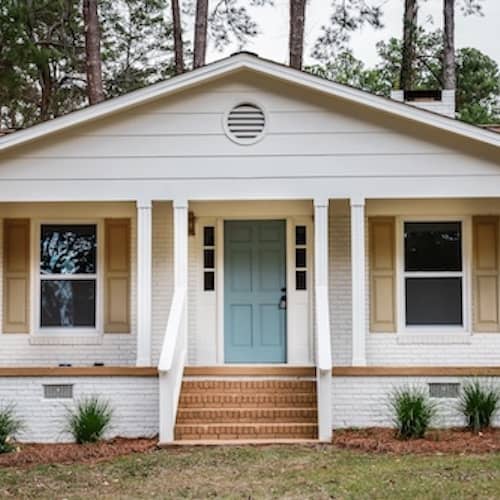What is a rambler house? 5 types of ranch-style homes
Jun 19, 2023
•5-minute read
Home buying can be a tricky process, from finding the right fit for your lifestyle to finding the perfect location. If you’re looking to buy a home, you’ll more than likely come across a rambler house. Also known as a ranch-style home, this type of house is unique because it’s typically only one story and has an L or U shape.
Ramblers have had a recent resurgence given their boxy layout and vintage appeal. You might still be wondering, “What is a rambler house?”
There’s more to these historical homes than meets the eye. While they were first designed in the 1930s, they grew in popularity following World War II, as more families wanted to live in quiet suburban neighborhoods. Keep reading to learn more about how the rambler home came about and the modern renditions of the classic style.
Table of contents
What is rambler style? 10 characteristics
- Low-pitched gable roofs
- Extended eaves
- Usually one story
- Post and beam ceilings
- Open floor plan
- Sliding glass doors
- Large windows
- L or U shape
- Attached garage
- Wide horizontal profile
These characteristics work together to make this type of home well-suited for Southwestern climates and those who love nature.
Ramblers’ low-pitched gable roofs and extended eaves provide more shade in sunny climates. The single-story, open floor plan, which creates an L or U shape, is ideal for energy efficiency and climate control.
With large windows or sliding glass doors, this home style emphasizes a connection to the outdoors.
What is the difference between a ranch and a rambler?
Ramblers and ranch houses are interchangeable terms. However, ramblers are known for being a single-story home style with their entry on the ground level and having a square or rectangular shape. The one difference is that ranch homes can also have a basement, which may be partially or fully furnished.
5 types of ranch-style rambler homes
There are five overarching types of ranch-style rambler homes. They include, but aren’t limited to, the California ranch, raised ranch, suburban, split-level and storybook ranch.
California ranch
The original rambler home was actually a California ranch designed by Cliff May in the 1930s. As the first ranch-style home, the California ranch is known for its L- or U-shaped floor plan paired with a courtyard at the very center of the house.
Raised ranch
The raised ranch home style takes the rambler home and updates it with a raised walk-up or stairs, which are used to enter the home. Raised ranches are also called “split-entry,” with structures like garages or storage space underneath the kitchen, living room and bedrooms.
Suburban ranch
While it is smaller and simpler than the traditional rambler home, the suburban ranch style is known for being a modern rendition of the ranch style built on slabs of concrete. They also maintain the openness of the California ranch to blend with the outdoors while being smaller in size and, consequently, more manageable for homeowners.
Split-level ranch
A split-level ranch is a type of rambler home with multiple levels, as opposed to the traditional one-story California ranch. On each level, there is a half-staircase that separates them. This also allows the home to display an open floor plan that goes from the entryway and connects to other areas of the home like the living room, dining room and kitchen.
Storybook ranch
Finally, the storybook ranch is a more ornate and decorative version of the rambler home. There is often a trim and different-shaped windows to give a more distinctive look to an otherwise traditional home. Instead of opting for the classic minimalist ranch style from earlier periods, the storybook ranch embodies a unique aesthetic with subtle differences from the simple rambler home.
If you’re on the search for your dream home and one of these types of rambler homes appeals to you, it’s a great time to get started on the mortgage process.
How to know if a rambler is right for you
The bottom line: Determine if a rambler is right for you
Driving through a neighborhood on the West Coast or in the Southwest, you may recognize the flat and sprawled out architecture of a rambler house. As this home style makes a resurgence, some may argue that the minimalist and simple nature of the ranch home never goes out of style.
Home buyers should note that rambler homes aren’t suitable for colder climates since their low-pitched roofs allow ice dams to form. Ice dams occur when snow on top of your roof melts and then refreezes on the lower edge.
Another aspect of ranch homes to note is that you may encounter cold spots, as a one-story home doesn’t handle heat loss as well as a house with levels. In the cold winter months, it may be difficult for your heating system to warm the parts of your home that are farthest from the furnace.
As an ode to a simplistic, traditional American home, ranch-style homes take advantage of larger plots of land without the hassle of a multistory home. If you’re looking for a home style that seamlessly transitions from the indoors to outdoors with natural light and an open floor plan, a rambler house might be for you. Begin the exciting home buying process by submitting your mortgage application with the Home Loan Experts at Rocket Mortgage®.

Hanna Kielar
Hanna Kielar is a former section editor for Rocket Money and Rocket Loans® with a focus on personal finance, automotive, and personal loans. She has a B.A. in Professional Writing from Michigan State University.
Related resources
6-minute read
Modular vs. manufactured homes: What's the difference?
Modular and manufactured homes are both factory-built, but they have some key differences. Uncover the distinctions between modular and manufactured homes.
Read more
5-minute read
What is a contemporary home? A guide to design
Contemporary houses incorporate design elements that are popular at the time when they’re built. Use our guide to learn more about this architectural styl...
Read more

7-minute read
Loans for flipping houses: A complete guide
If you're looking to fix up and flip a real estate property, you'll usually need financing. Find out more about loan options and the application process.
Read more